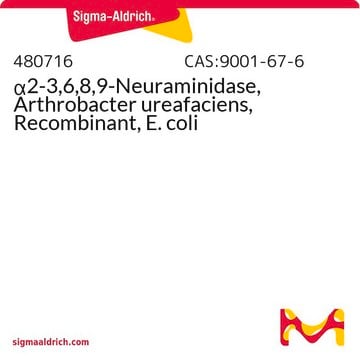10269611001
Roche
Neuraminidase (Sialidase)
from Arthrobacter ureafaciens
Sinónimos:
PCR, taq
About This Item
Productos recomendados
biological source
bacterial (Arthrobacter ureafaciens)
Quality Level
form
solution
specific activity
~25 units/mg protein
packaging
pkg of 1 U (100 μl)
manufacturer/tradename
Roche
optimum pH
5.0-5.5
storage temp.
2-8°C
General description
Specificity
Application
- cell surface lectin array analysis.
- hemagglutination assays.
- cell adhesion assay.
- detection of the cell surface glycosylations in human anaplastic large cell lymphoma cells
- release of sialic acid from cells
- antibody-overlay lectin microarray
Physical properties
Physical form
Preparation Note
Other Notes
signalword
Warning
hcodes
Hazard Classifications
Skin Sens. 1
wgk_germany
nwg
flash_point_f
does not flash
flash_point_c
does not flash
Certificados de análisis (COA)
Busque Certificados de análisis (COA) introduciendo el número de lote del producto. Los números de lote se encuentran en la etiqueta del producto después de las palabras «Lot» o «Batch»
¿Ya tiene este producto?
Encuentre la documentación para los productos que ha comprado recientemente en la Biblioteca de documentos.
Los clientes también vieron
Protocolos
Neuraminidase can be used to cleave sialic acids from proteins. In this protocol, the enzyme from Vibrio cholerae is used on fixed cells.
Nuestro equipo de científicos tiene experiencia en todas las áreas de investigación: Ciencias de la vida, Ciencia de los materiales, Síntesis química, Cromatografía, Analítica y muchas otras.
Póngase en contacto con el Servicio técnico







